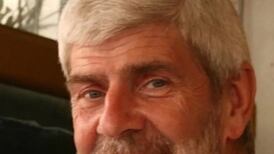Anne Crookshank, who has died in Milford, Co Donegal, was emeritus professor of the history of art at Trinity College Dublin, a department she herself established in 1966. She played a major role in the development of the history of Irish art as an academic discipline and was a hugely positive, energetic presence in academic and cultural life, as teacher, researcher, writer and activist for many decades.
She was born in Belfast, the middle of three sisters. Her father, Henry Crookshank, a Trinity graduate, had served with the Dublin Fusiliers during the first World War, and went on to work for the Geological Survey in India. Her mother was Eileen “Kitty” (née Somerville-Large). Anne spent her first five years in India, where her father was working on a survey of the central provinces.
With Anne, Eileen returned from India for the birth of her third daughter, Helen, in 1932. The girls were moved around a great deal as they grew up, including time in London, until they were evacuated during the Blitz to stay with a cousin in Carlyle and, later, a spell with an aunt, Olivia Hughes, in Fethard, Co Tipperary.
Hughes, well known as a founder of the Fethard Guild of the ICA, was an influential figure in their lives. Anne then attended Alexandra College for a year. When she won a scholarship to Oxford, her father intervened, saying the family always went to Trinity. She studied history there and it was her professor, Theo Moody, who encouraged her to pursue her interest in art. She went on to the Courtauld in London and began her professional working life at the Tate.
Municipal disapproval
As keeper of painting in the Ulster Museum (then the Belfast Museum and Art Gallery) from 1957, she was a progressive force, driving an acquisitions policy that encompassed works by contemporary international artists, often in the face of municipal disapproval. In Belfast, she became close to the sculptor Deborah Brown and the two remained friends for life.
She met Desmond and Mariga Guinness shortly after they had founded the Irish Georgian Society in 1958, and through them met Desmond FitzGerald, the Knight of Glin. She was an active member of the society for over 50 years, and she and FitzGerald soon began a series of joint projects that extended over many decades.
Scholarly disagreements and vigorous debate were integral to their fruitful collaboration. When she moved to Trinity she faced the daunting prospect of building a history of art department from scratch.
Aware that architecture had to be addressed but was not her primary interest, she was keen to enlist an architecture specialist and in 1973 Dr Edward McParland became lecturer in architectural history.
Landmark exhibition
With FitzGerald she did extensive research in preparation for a landmark exhibition and publication:
Irish Portraits 1660-1860
, published by the Paul Mellon Foundation for British Art, mapped a new art historical territory to a degree that is hard to imagine now. It was the first historical show of Irish portrait painting and, following its run at the National Gallery of Ireland, travelled to the National Portrait Gallery London and the Ulster Museum Belfast.
It revealed, as they put it, “a hitherto unknown and not inconsiderable facet of what is normally called British art. This Irish facet has been left untouched, even in its own country . . .” Their meticulous research elevated the standing of several previously overlooked artists, including James Latham.
Largely through their efforts, Irish portrait painting and Irish art in general became lively areas of research. They went on to publish a major study, The Painters of Ireland c.1620-1920, in 1978, the first of its kind since Walter Strickland's standard 1913 Dictionary of Irish Artists. Their volume was revised and expanded in 2002 as Ireland's Painters 1600-1940. In the meantime they'd produced The Watercolours of Ireland in 1994.
She became very fond of Donegal, and in about 1984, she bought a house in Ramelton. Over time managed to base herself there, to the approval of every stray cat in the locality. Not only did she feed the cats, she abhorred lethal mousetraps.
Benchmark publications
She weathered two bouts of cancer with courage and without complaint. She made regular working trips to Dublin to attend meetings of the many organisations with which she was involved, including the Royal Irish Academy, the Castletown Foundation and several charities. Within a few years, Deborah Brown also bought a house in the town and they saw each other regularly. Anne and FitzGerald, who died in 2011, made a major contribution to the library of the Irish Art Research Centre in Trinity College, the Crookshank-Glin collection of tens of thousands of reproduction images of work by more than 1,000 Irish painters and sculptors from about 1600 to 1940. This collection was the basis of their benchmark publications.
Her elder sister, Elizabeth, died last year. She is survived by her sister Helen and her nieces and nephews.








